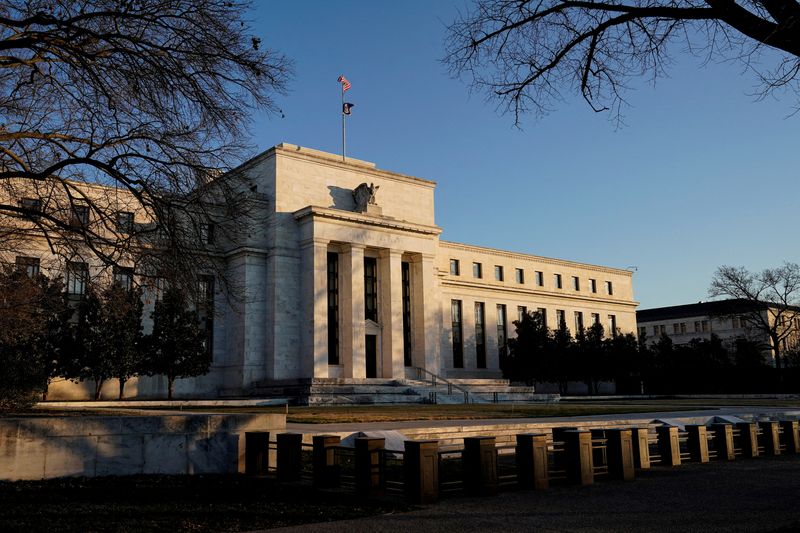LONDON (Reuters) – Whether emerging economies have already done enough to pre-empt the global central bank tightening cycle may dictate whether investors in them can escape yet another dire decade.
With everyone braced for the U.S. Federal Reserve’s first post-pandemic interest rate rise next month, clouds appear to be gathering over emerging economies once again.
The prospect of a rising U.S. Treasury yields and appreciating dollar is typically a twin torture for governments and companies heavily borrowed in greenbacks – an exposure few in the developing world have been able to shake.
And given that emerging stocks as a basket have never truly recovered from the last Fed ‘liftoff’ that began with the so-called ‘taper tantrum’ of 2013, the outlook appears bleak as they face a second liftoff again in less than 10 years.
One of the few positives is most investors seem to have skedaddled already.
Funds’ positioning in global emerging markets equities fell to net 2% underweight last month, according to Bank of America fund manager survey. That was a full standard deviation below long-term averages and a eye-watering reversal of the net 60% overweight seen as recently as late 2020.
There’s been no let up this year. EM funds did not escape a generally wobbly start to the year everywhere – with last week seeing the 7th consecutive week of net outflows from emerging equity and a 4th straight week of exits from EM bond funds.
For all the national pros and cons missed by broad EM index investing, it’s hard to imagine a worse constellation over the past year for MSCI’s benchmark emerging equity index – one that’s now almost 50% Chinese and Taiwanese companies.
Aside from the drama of the pandemic itself, exaggerated in recent months by China’s “Zero COVID” policies while other economies kept largely open through the Omicron variant, rising dollar interest rates and fractious geopolitics between the West and both Beijing and Moscow has rankled like never before.
The near collapse of China’s debt-laden property sector and the government’s crackdown on the country’s tech giants as part of its “common prosperity” push jarred even more.
Amid all that, the investment world was forced to enter 2022 on tenterhooks over a possible Russia invasion of Ukraine – a standoff that last week seemed to cement China/Russia alliance in opposition to G7 and NATO, exaggerating the global energy price and inflation crisis in the process and upping pressure for higher U.S. interest rates.
(Graphic: Emerging Markets Central Bank Rates, https://fingfx.thomsonreuters.com/gfx/mkt/dwvkrjyznpm/One.PNG)
(Graphic: EM indices relative performance vs S&P500 since 2013’s ‘Taper Tantrum’, https://fingfx.thomsonreuters.com/gfx/mkt/zjpqkamylpx/Two.PNG)
DARKEST BEFORE DAWN?
There are those who think the darkest hours are before dawn; or that EM will win when ‘value stocks’ have their day; and even that extreme positioning provides opportunities. That’s led to some calling for a return to emerging equity at the strangest time.
Some of the thinking is simply eyeing a turn in sentiment toward China as the pandemic endgame unfolds and the People’s Bank of China bucks a global central bank trend with easing of its own.
Others reckon a peak-to-trough 18% drawdown in MSCI’s equity benchmark over the past 12 months has run its course as a result and a ‘bear market’ signal in the event of a recoil of more 20% just isn’t warranted.
Some also think emerging companies should benefit from pumped up oil and commodity prices driving decades-high global inflation rates – although tech stocks are now a bigger overall weighting in the MSCI’s index than materials, energy and industrials sectors combined.
And tech stocks don’t like higher yields much.
A more cogent hope is that many emerging market central banks have dodged the oncoming bullet of a soaring dollar against their currencies by tightening sharply in advance.
In the year before the Fed has even contemplated rate rises, Brazil’s central bank has hiked its policy interest rate by almost 9 percentage points to 10.75%; Chile added 5 points to 5.5%; and Russia and South Korea doubled their equivalents to 8.5% and 1.25%.
If that pre-emption reins the dollar in during this Fed hiking cycle – and China continues to ease further – it may just allow emerging central banks some breathing space to end their tightening earlier, offering attractions to bond investors fearful of what developed world fixed income has in store.
That’s a big ‘if’ and goes against consensus views on the dollar for this year.
But it does speak to other hopes that the model of emerging economy growth is shifting away from a reliance on exports to more home-grown drivers of domestic demand.
“Emerging markets are breaking away from their dependence on the developed world,” said Columbia Threadneedle’s head of global emerging equities Dara White.
“Investors should now be looking at emerging markets through a different lens,” he added.
End of a lost decade? We’ll see after March.
(by Mike Dolan, Twitter: @reutersMikeD; Editing by Alexandra Hudson)



















